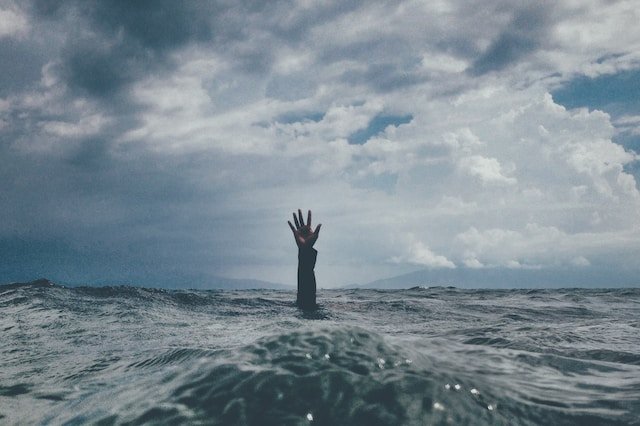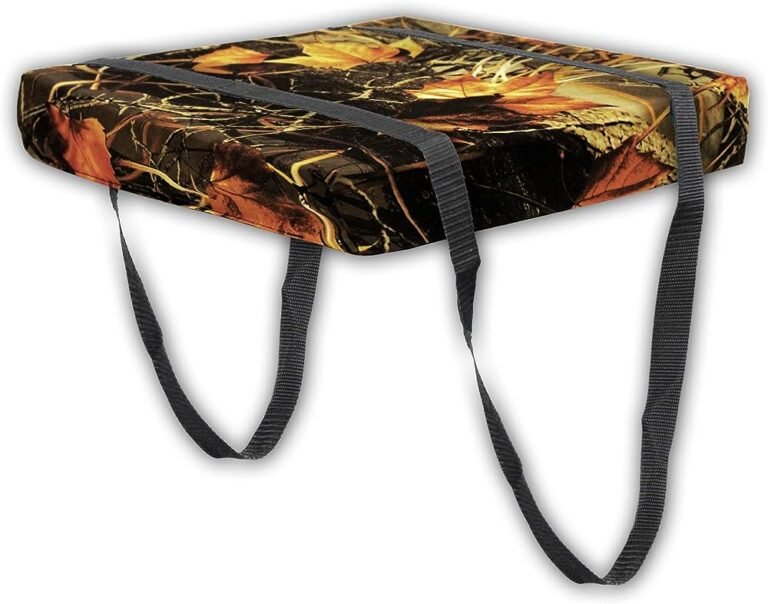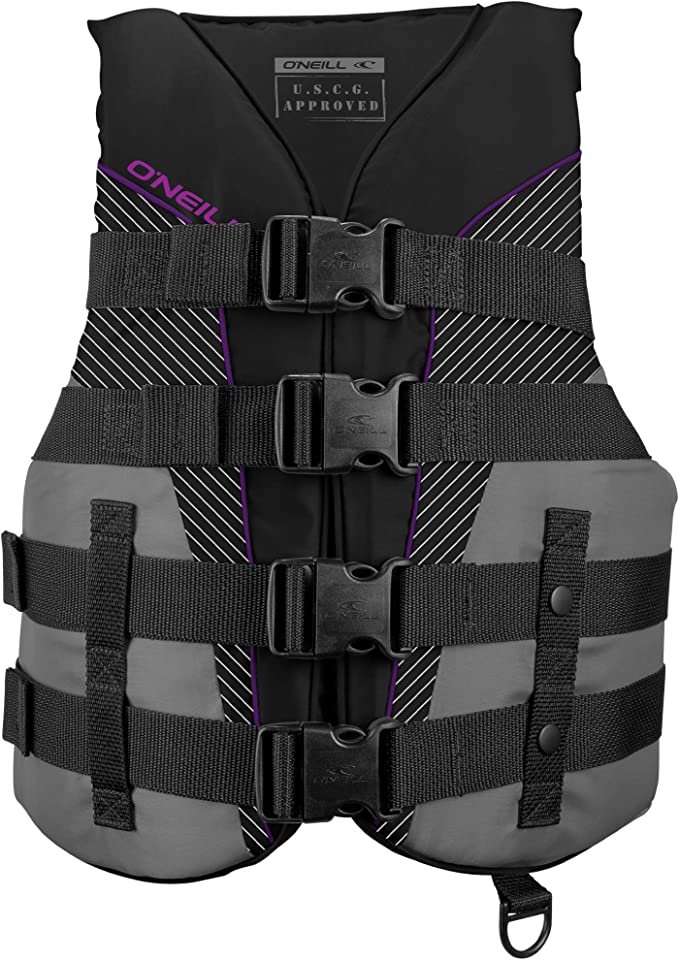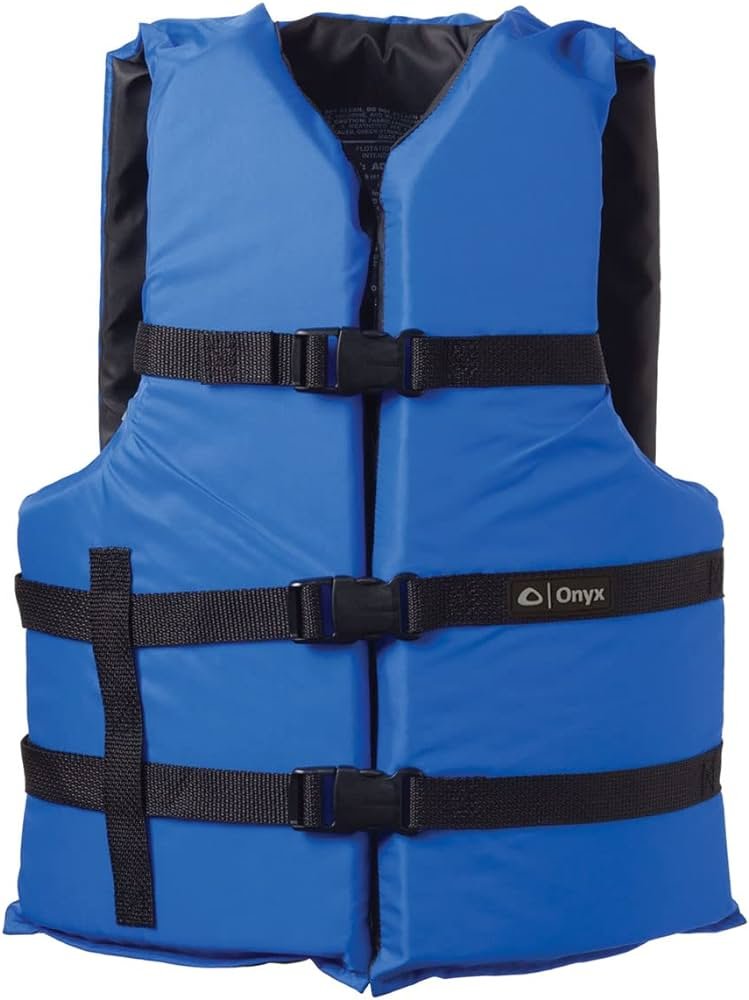10 Best Kids Life Jackets To Buy In 2024
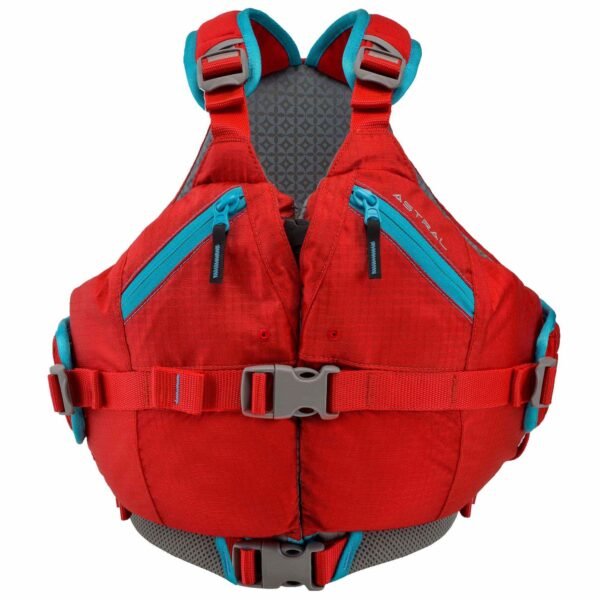
As a parent, one of your major concerns is the safety of your child. Keeping them safe and protected is a duty that you carry out daily. But kids will be kids, and keeping them safe can appear difficult at times, especially if they love to play hard and explore.
That’s why getting your child a life jacket when visiting the beach or going on family vacations is necessary. Although most states require kids under 13 to wear life jackets when on water, that doesn’t mean you should just pick any life jacket for them! Your child deserves the best.
Don’t worry, we got you. Just sit tight, we’ll show you the top 10 kids’ life jackets out there in the market right now and answer your FAQs. You’re in safe hands. But before we begin, there are one or two things you need to know first to make choosing the best kids’ life jacket for your child easier.
Types of Personal Floatation Devices
If you are a boat owner or regularly participate in water sports, then you should be familiar with the term PFD (Personal Flotation Device). There are five types of PFDs meant for different activities and situations. It is essential to know the difference between them.
Type I: Offshore Life Jackets
Type I PFDs were created for situations where it might take a while before you’re rescued. These vests are intended for use in rough or isolated seas. They are designed to be the safest life jackets providing you with high coverage and maximum flotation.
What sets the Type I PFDs apart from the other types is that they can flip you over in case you end up face-down while in water. This will stop you from drowning even if you’re unconscious.
Type II: Near-Shore Vest
The Type II PFD, Near-shore vest, is as its name suggests. Type II life jackets and vests are meant for trips on calmer waters, where there’s a higher chance of being rescued quickly.
They are designed with less floatation than a Type I PFD and only a couple of near-shore vests have the ability to turn you over in the water. Although they’re less buoyant, they are more comfortable than Type I PFDs.
Type III: Flotation Aids
Flotation aids are best suited for leisure activities such as kayaking, fishing, etc., in areas where, if needed, rescue is immediate. The buoyancy of a Type III PFD is similar to that of a Type II PFD, but they aren’t meant for prolonged survival in rough waters.
It is more comfortable than the other types of PFDs, however, they need to be worn face-up since they won’t be able to turn you over in the water.
Type IV: Throwable Devices
If you have a boat or water vessel that measures 16ft or longer, kayaks and canoes excluded, then you should have a Type IV PFD on board where it can easily be accessed.
If you plan on renting a boat too, then make sure one is on board. Unlike the above-mentioned PFD types, they are meant to be thrown to someone in the water if they are conscious.
Type V: Special-Use Devices
As the name suggests, Type V PFDs are meant for special use. These jackets and vests are just as buoyant as Type I PFDs but they are designed with extra features designed specifically for their purpose.
For example, deck suits, kayak rescue vests, sail harnesses, etc., are all classified as Type V vests since they have extra features for that specific activity.
Our Top 10 Life Jackets For Kids
1. Stearns Original Puddle Jumper Kids Life Jacket
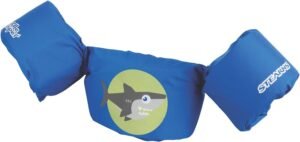
The Sterns Puddle Jumper is a life jacket that tops our list for many reasons. Firstly, this type V/III personal flotation device is a US Coast Guard-approved life jacket, so you can be sure that whether you’re taking your kids to a water park, the beach, or on a boat, this jacket will meet all the necessary safety requirements.
The Puddle Jumper is designed with adjustable straps allowing it to snugly fit children weighing 30 to 50 lb. It’s made with a nylon shell, which not only makes it durable but also gives your child the freedom to run and play freely close to or in the water without bothering your child.
For your serenity, Sterns also added an extra feature of safety buckle snaps along the back of the Puddle Jumper stopping your kids from taking off the life jacket on their own. The Paddle Jumper is also a great item to consider getting if your child is still learning how to swim.
What we love about the Puddle Jumper is that it comes in so many different colors and designs. With over ten different cute designs available, your little one will have fun picking the right life jacket that’s perfect for them. In a nutshell, the Stearns Original Puddle Jumper Kids Life Jacket is a great purchase for your tot.
Key Features:
- PFD Type: V/III
- U.S. Coast Guard Approved PFD
- Material: Nylon
- Colors available: 10+
- Sizing: 30 – 50 lb
2. Body Glove Paddle Pals Life Jacket
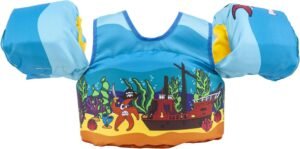
Here is another colorful life jacket joining the list. The Body Glove Paddle Pals Life Jacket is another type V/III personal flotation device that is not only US Coast Guard approved but is also Transport Canada approved, so no matter the location or water-based activity, this life jacket is designed to meet all the needed requirements. The adjustable straps on the back of life jackets makes them a snug fit for children of ages 2 to 6 (33 to 55 lb).
Like the Puddle Jumper, the Body Glove Paddle Pals life jacket is available in over 10 different colors and graphic designs. With such a large variety of fun designs to choose from, getting your child a life jacket, they will love is so much easier.
This polyester life jacket has a multi-panel design that stops chaffing meaning your child can play in comfort and style. The jacket is also very durable, so just know you’ll have it with you for a long time.
Body Glove also designed the Paddle Pals life jacket with a safety shoulder harness to ensure that it stays secure, preventing the life jack from sliding off when worn, and a strap with a buckle system to stop your little one from taking off the life jacket themselves.
Key Features:
- PFD Type: V/III
- U.S. Coast Guard and Transport Canada Approved PFD
- Material: Polyester
- Colors available: 10+
- Sizing: 33 – 55 lb
- Warranty: 90 days
3. STEARNS Youth Boating Jacket
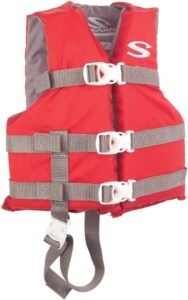
Now, let us take a look at a life jacket for our older kids. We don’t wanna leave them out now, do we? If your kids are between the ages of 7 to 12 (50 to 90 lb), then the STERNS Youth Boating Jacket just might be the life jacket they need.
It comes with three adjustable buckled straps in front that you can tighten or let out to ensure a provide a comfortable fit for your youngster. It’s a category III personal flotation device, that is US Coast Guard-approved and that is perfect for all boating activities, swimming, waterskiing, etc.
The Youth Boating Jacket is an open-sided life jacket, constructed with durable nylon, which helps prevent chaffing making it comfortable to wear, and filled with PE flotation foam, so if your child does end up in the water, this life jacket will keep them afloat.
Unlike the Puddle Jumper which dazzled us with its numerous designs and color options, the Youth Boating Jacket is only available in two different color variations, blue and red. However, since it is built to match the adult boating jacket, you and your child can don the same jacket while out on the water.
Key Features:
- PFD Type: III
- U.S. Coast Guard Approved PFD
- Material: Synthetic (Nylon)
- Colors available: 2 (Blue and Red)
- Sizing: 50 – 90 lb
4. STEARNS Child Classic Series Jacket
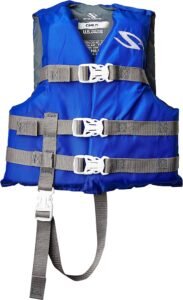
You’ll know a brand provides great quality when it provides amazing products, and Stearns is doing just that with another addition of one of their life jackets to our list.
The Stearns Child Classic Series Jacket is very similar to the Youth Boating Jacket. It’s made with the same comfortable nylon material that your kids will love moving around in, and it also has three adjustable buckles that can be tightened or loosened to fit your child perfectly.
One major difference between the Stearns Child Classic Series Jacket and the Youth Boating Jacket is that the has an included buckled leg strap to help ensure that your little ones fit securely in the life jacket.
One point of difference is the sizing of the jacket. While the Youth Boating Jacket is made for older kids, the Child Classic Series Jacket fits younger children between 30 to 50 pounds. Like the Youth Boating Jacket, it also comes with only two-color variations available, blue and red.
So, if you’re looking for something colorful and stylish, this might not be the one for you, however, the Stearns Child Classic Series Jacket is a very practical life jacket that will serve you and your little one well.
Key Features:
- PFD Type: III
- U.S. Coast Guard Approved PFD
- Material: Nylon
- Colors available: 2 (Blue and Red)
- Sizing: 30 – 50 lb
- Leg Strap included
5. Stohlquist Fit Youth Life Jacket
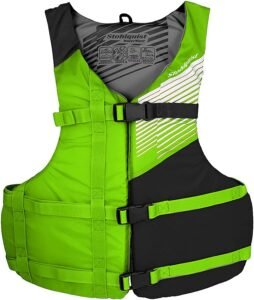
Stohlquist has put a lot into the design of this great life jacket. The Fit Youth Life Jacket was developed to ensure that your kids are able to run, swim, and play however they want.
Its non-resistivities cut and sculpted foam paneling ensures that your kids get all the mobility they need. This makes this life jacket perfect for different water sports and activities, such as boating, kayaking, rafting, etc.
The Fit Youth Life Jacket also makes use of three adjustable buckles so that you can easily tighten or loosen the jacket, but because these straps are designed with box-stitched webbing, they will also last longer than the more common bar-tac stitching used by more economic brands.
This type III US Coast Guard-approved personal flotation device is also available in four different colors and three different size ranges. So right from our tiny tots, to our big kids, and even our teens, there’s a Stohlquist Fit Youth Life Jacket for them. The smaller size range (30 -50 lb) life jacket also includes a leg strap to provide that extra bit of safety for your little ones.
Key Features:
- PFD Type: III
- U.S. Coast Guard Approved PFD
- Material: Polyethylene Foam
- Colors available: 4
- Sizing: 30 – 50 lb, 50 – 90 lb, 75 – 125 lb
- Size 30 – 50 lb has a leg strap included
6. STEARNS Infant Classic Series Life Vest
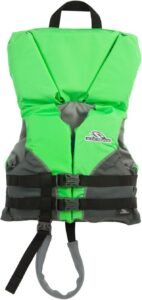
This is the first life jacket included in the list meant for our babies. The Stearns Infant Classic Series Life Vest was similar to the Child Classic Series but with the required modifications made to fit our toddlers better, so if you’re shopping for a life jacket for your infant, then you should look no further.
This type II PDF has various added features to ensure the safety of your little one. The security buckled straps and zipper keep children safe while also making it simple for mum or dad to put on this life jacket.
The double collar design will protect your children’s heads in the water, and a grab handle on the collar makes it simple to hang the jacket to dry and grab your toddler quickly if necessary. The leg strap included Stearns Infant Classic Series Life Vest also prevents the jacket from sliding off.
Key Features:
- PFD Type: II
- U.S. Coast Guard Approved PFD
- Material: Nylon with PE foam
- Colors available: 2 (red and blue)
- Sizing: Under 30 lb (8 – 30 lb)
- Leg strap and grab handle included
7. STEARNS Infant Puddle Jumper Hydroprene Life Jacket
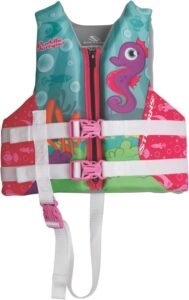
Here’s another life jacket perfect for our little babies also created by STEARNS. The STEARNS Infant Puddle Jumper Hydroprene Life Jacket is a type III personal flotation device that is US Coast Guard-approved, making it perfect for water activities that require you and your child to be out on the water.
It’s made with a soft hydroprene shell that will keep your tiny tots comfortable while wearing the life jacket. What we love about the Infant Puddle Jumper Life Jacket are the additional features that STEARNS included in its design that provide that extra safety and protection your child needs near or in water.
One of those features is the large head support which will help keep your child face-up in the water. It also has leg straps to keep your child secure and a grab handle you can use to pull your child out of the water when necessary.
As mentioned before, the STEARNS Infant Puddle Jumper Life Jacket is designed for babies and tots under 30 pounds, and with 4 different color variations possible, you can get a life jacket that is perfect for your little prince or princess.
Key Features:
- PFD Type: III
- U.S. Coast Guard Approved PFD
- Material: Hydroprene with Crosstech flotation foam
- Colors available: 4
- Sizing: Under 30 lb (8 – 30 lb)
- Leg strap, head support, and grab handle included
8. HeySplash Swim Life Jacket Vest
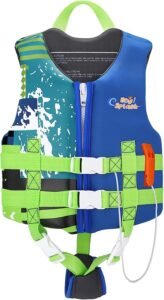
The HeySplash Swim Life Jacket Vest was designed with both safety and comfort in mind. This life jacket is crafted with Neoprene, Nylon, and EPE (Expandable Polyethylene) making it super buoyant but comfortable to wear.
It has large armholes to ensure that your kids can play and run around without feeling restricted and leg straps to stop the life jacket from riding up.
Unlike all of the previously mentioned life jackets, the HeySplash Swim Life Jacket Vest comes with an included safety whistle, with a 33ft radius, that your child can blow to grab your attention in dangerous situations.
It is available in 9 different colors and designs, that are highly visible in the water, and two different sizes (medium and large) making your children stylish and safe. It comes with adjustable straps and a heavy-duty zipper, keeping the life jacket secure while they play.
Although the HeySplash Swim Life Jacket Vest isn’t U.S. Coast Guard approved, the life jacket has passed the UL 12402-5 (Level 50) tests, which means that it meets all specific safety and performance requirements. To make the most of this life jacket, make sure that it is stored in a cool, dark place and not in direct sunlight or near heat.
Key Features:
- PFD Type: III
- Material: Nylon, Neoprene
- Passed the UL 12402-5 (Level 50)
- Colors available: 9
- Sizing: M (33 – 55 lb), L (55 – 77lb)
- Leg strap and safety whistle included
9. Stohlquist Infant PFD Life Jacket
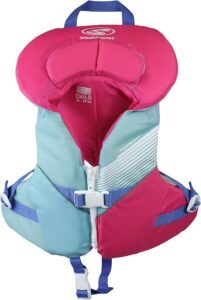
Here’s a life jacket for our tiny tots from Stohlquist. The Stohlquist Infant PFD Life Jacket is a type III PFD that’s perfect for infants. It is made with super comfortable polyethylene foam and designed to give your little ones maximum mobility, making it perfect for all sorts of water sports and activities.
Like the STEARNS Infant Paddle Jumper, the Stohlquist Infant PFD Life Jacket provides head support and comes with a grab handle making it easier to pull your child out of the water.
Due to the head support, the Stohlquist Infant PFD Life Jacket always turns your kids face up when they’re in the water making it easy for them to float safely. It also comes in three different color designs that are easy to spot when in or near the water.
It has durable box stitched front, side, and leg straps to keep your child secure in the life jacket and prevent them from slipping out of the life jacket. All straps are adjustable making it easy to either tighten or loosen the life jacket as required to make it the perfect fit for your child.
Key Features:
- PFD Type: III
- U.S. Coast Guard Approved PFD
- Material: Polyethylene foam
- Colors available: 3
- Sizing: Under 30 lb (8 – 30 lb)
- Leg strap, head support, and grab handle included
10. Oceans7 US Coast Guard-Approved Youth Life Jacket
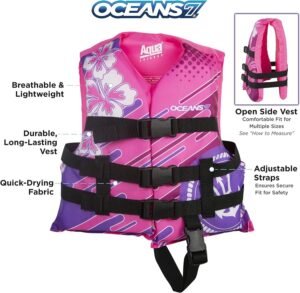
Last but not least on the list is the Oceans7 US Coast Guard-Approved Youth Life Jacket. This type III PFD life jacket is meant for kids between 50 to 90lbs and is US Coast Guard Approved, therefore, meeting all safety and performance requirements.
It’s made with nylon and expandable polyethylene foam which guarantees high floating ability and makes it great for all types of water sports and activities.
The Oceans7 Youth Life Jacket has an open-side design allowing for maximum mobility so your kids can run about and play without feeling restricted in their life jacket. It also has 3 adjustable front straps that can be tightened or loosened to get the perfect fit for your child.
The only downside that the Oceans7 Youth Life Jacket has is that it was designed with girls in mind so unless your child likes pink, they might not be so eager to put on this life jacket. On the other hand, the life jacket is lightweight and also dries quickly making it easy to dry and store after a fun day out with the kids.
Key Features:
- PFD Type: III
- U.S. Coast Guard Approved PFD
- Material: Nylon and Polyethylene foam
- Colors available: 1 (Pink/Berry)
- Sizing: 50 – 90lbs
Types of Life Jackets
Not all life jackets are the same and not all life jackets are child-friendly. There are three different types that you need to know about; inherently buoyant, inflatable, and hybrid life jackets.
Inherently buoyant: These life jackets are constructed mainly out of foam, neoprene, and similar materials that are inherently buoyant. They’re perfect if your child doesn’t know how to swim yet. Unlike inflatable life jackets and vests, they don’t have the risk of being punctured when in use.
Inflatable: Inflatable life jackets are meant to be inflated before use. They are easier to store, more comfortable, and less bulky when compared to an inherently buoyant life jacket.
Most inflatable life jackets can be inflated by blowing orally into the jacket, however, there are some jackets designed to inflate automatically.
Although they might seem like a cheaper alternative, inflatable life jackets can only be used by 16-year-olds and older, and are not suitable for non-swimmers.
Hybrid: Hybrid life jackets are a combination of inherently buoyant and inflatable life jackets. It is designed with inflatable chambers and inherently buoyant materials to create buoyancy and flotation.
With Hybrid jackets, the risk of having your jacket punctured while on the water is reduced. They also provide great maneuverability.
Swim Vests and life Jackets, are they the same?
You might have heard people use the terms swim vest and life jacket interchangeably. You might have even thought of getting a swim vest first. That’s totally understandable, but you made the right call by choosing to get your child a life jacket instead of a swim vest.
Although they may look the same, there’s a big difference between the two, and that difference could be critical in some scenarios.
A swim vest, like most buoyancy aids, will help you swim if end up in the water. They’re perfect for trips to the pool but they can’t be classified as a PFD. A life jacket, on the other hand, is designed to make you float even if you can’t swim. Some will even turn you over when you’re in the water.
Most swim vests are not even up to half as buoyant as regular life jackets are. So, for the safety of your child, choosing to get a life jacket instead of a swim vest is the better option.
Choosing a Life Jacket for your Child
Before you take a look at our picks for the top 10 kids’ life jackets, check out this guideline below first. It is important that you know what to look out for when choosing a life jacket for your child.
Sizing: Getting the right-sized life jacket is vital. There’s really no point in a life jacket that’s too small or too big to fit your child. However, picking the right size can be hard especially if you are ordering from online stores.
Unlike adult life jackets, kids’ life jackets are sized by weight, with infant life jackets for children weighing 8-30 pounds, child life jackets for children weighing 30-50 pounds, and youth life jackets for children weighing 50-90 pounds.
U.S. Coast Guard-Approved: When shopping for a life jacket for your child, make sure that they’re U.S. Coast Guard-Approved before you even consider buying it. This is the best measure of safety for life jackets.
Not all life jackets have been given that stamp of approval from the U.S. Coast Guard, so why risk it? Play it safe and get a life jacket that has been U.S. Coast Guard-approved.
Materials: As mentioned before, there are three types of life jackets, however, since inflatable jackets can only be used by kids ages 16 and up, if you have a younger child, you’ll probably have to decide between getting an inherently buoyant life jacket or a hybrid one.
Inherently buoyant life jackets are more durable and require less maintenance, however, a hybrid life jacket is more comfortable and greater for extended use.
Use: Your choice of life jacket for your child should depend largely on the boat your child will board and the water activities he/she plans to do. It’s important that your child’s life jacket is appropriate for the situation.
You can always play it safe by getting your child a Type I life jacket, but it might be a bit of an overkill if they just partake in general boating activities like kayaking.
If you plan to go on trips to rivers and lakes instead of visiting the open sea, then a Type II or Type III life jacket would be the better choice.
Extra Features: Besides size, there are some other features that life jackets should have to make them suitable for infant and child use. A kids’ life jacket should have a crotch strap and head pillow or head support.
The crotch strap will prevent the jackets from slipping off their bodies over their heads, while the head pillow will keep their heads above the water.
A life jacket with bright colors will make it easier to spot your child and look out for a life jacket with a grab handle too. The handle will make it easier to carry your child out of the water.
Practice: Before taking your child out to the water, let them practice wearing the life jacket a couple of times beforehand. This is especially important with younger kids who may be a bit fussy about wearing their life jackets.
Practicing will get them familiar with wearing it, making putting it on less of a chore. Don’t be afraid to take your child to a pool and let them swim with the jacket on. This is also a great way to check if the jacket fully supports your child in a safe and controlled environment.
Life Jacket Safety Tips
In all that we do, it’s important that we put safety first. So, before you head out on the water, here’s a list of some life jacket safety tips that you and your child might need.
- Ensure that your kids always wear a life jacket: Make sure that your kids always wear a properly fitting life jacket while on or near the water.
- Choose the right type of life jacket: Different PFDs are made for different activities, that’s why you should make sure that your child’s life jacket is appropriate for the water activity and environment they will find themselves. Also, double-check that their life jacket is U.S. Coast Guard-approved.
- Always check the fit of their life jacket: A properly fitting life jacket should be snug around the waist and chest, but allow for free movement of the arms, so carry out fit checks on your child before heading out to the water.
- Replace worn or damaged life jackets: Be on the lookout for any holes or tears in your child’s life jacket especially if they like to play rough. If you do notice that the life jacket is worn or damaged, do not hesitate to get a new one as tears, holes, or frayed edges can affect the life jacket’s performance.
- Teach children how to swim: Take the time out to give your child the swimming lessons they need. Even though having a life jacket provides important flotation, being able to swim will help them get out of risky situations. They’re never too young for some lessons in the pool.
- Supervise your children: Always make sure that either you or another responsible adult is watching over your kids when in or near the water. Doing this provides an extra layer of protection and also reduces the chances of an accident occurring.
- Avoid alcohol: Avoid drinking alcohol when boating or out with your children near the water. It may sound like a buzzkill but alcohol impairs judgment and reaction time. It’s better to be safe than sorry.
By following these safety tips, you and your child can have a safe and enjoyable time while participating in water activities.
Caring for your Life Jacket
Ensuring that your life jacket is properly cared for to key to getting the most out of it. So, if you want to make your child’s life jacket last longer, you can follow these tips:
- Store the life jacket properly: When not in use the life jacket should be stored in a cool, dry place away from direct sunlight and heat sources as these will weaken the material.
- Cleaning: Clean your life jacket regularly to remove dirt, salt, and other debris. You can use a mixture of mild soap and water to clean it, but make sure to hang it to air dry completely before storing. Storing it wet will damage it.
- Avoid sharp objects: When you’re in or near water with kids, keep them away from sharp objects, such as rocks or hooks, which can tear or puncture the material to protect the life jacket.
- Regularly check for wear and tear: Inspect the life jacket on a regular basis for any damage, such as tears or worn seams, and replace it if you feel it is necessary.
- Follow manufacturer’s instructions: Many manufacturers include tips on how to properly maintain the life jacket so make sure you read and follow the manufacturer’s instructions to care for the life jacket.
By following these tips, you can extend the life of your child’s life jacket and ensure it will be ready to use when they need it.
Frequently Asked Questions
How do you fit a kids’ life jacket?
Many parents get worried now and then about getting the right fit for their child. This is especially more difficult to do when buying a life jacket for them online. But, don’t worry, getting the right size of life jacket for your child comes down to two main factors: their weight and chest measurement.
With weight measurement, it all comes down to weighing your child and comparing it to the manufacturer’s weight recommendations for the life jacket.
On the other hand, with chest measurement, you’ll have to measure the widest part of the chest. This is usually across the nipple line and under the arms. You can then compare the measurement to the chest measurement chart provided by the manufacturers.
You may also want to plan ahead when getting a life jacket for your little ones by considering their age and growth rate. Although many kids’ life jackets come with adjustable straps, ensuring that they won’t outgrow them too is very important.
In the worst case scenario, in which the order life jacket is too big or too small for your child, do not be afraid to return it and request a better fit from the store.
How to wear a kids’ fishing life jacket?
Getting your child in their life jacket can be a hassle sometimes. Kids will turn into world champion WWE superstars get out of wearing their life jackets, so here’s how you can get your child into their life jacket in 6 easy steps.
Step 1: Open the life jacket
Start by opening the life jacket and laying flat on the table or the ground.
Step 2: Get your child to step into the life jacket
Once they’re in the life jacket, you can put their arms through the armholes.
Step 3: Fasten the front buckle
Once their arms are in the armholes, you can fasten the life jackets’ front buckle. If the life jacket has a leg strap, fasten the buckle on that too.
Step 4: Adjust the side straps
You might have to tighten or loosen the side straps of the life jacket around the child’s waist as needed. Make sure that the life jacket is snug and that the bottom of the life jacket sits on their hips.
Step 5: Fasten the shoulder straps
Although most children’s life jackets don’t have shoulder straps, if your child’s life jacket has shoulder straps, fasten them as required.
Step 6: Check the Fit
Remember to double-check that the life jack is snug on your child, and not too tight or too loose. Their arms should be free to move and not restricted by the life jacket. Also, check that it does not ride up over their chin or face when they’re in the water.
As mentioned before, to make the process even easier, try practicing wearing the life jacket with your child before heading out on the water. This will give them time to get familiar with being in a life jacket, feel more at ease in one, and also better understand how the life jacket works.
Although a lot of great life jackets have been mentioned in the list, with Stearns Original Puddle Jumper Kids Life Jacket topping the list, the best life jacket for you is the one that meets all of your needs. Therefore, before choosing a life jacket for your children, ensure that they tick all the boxes first.




